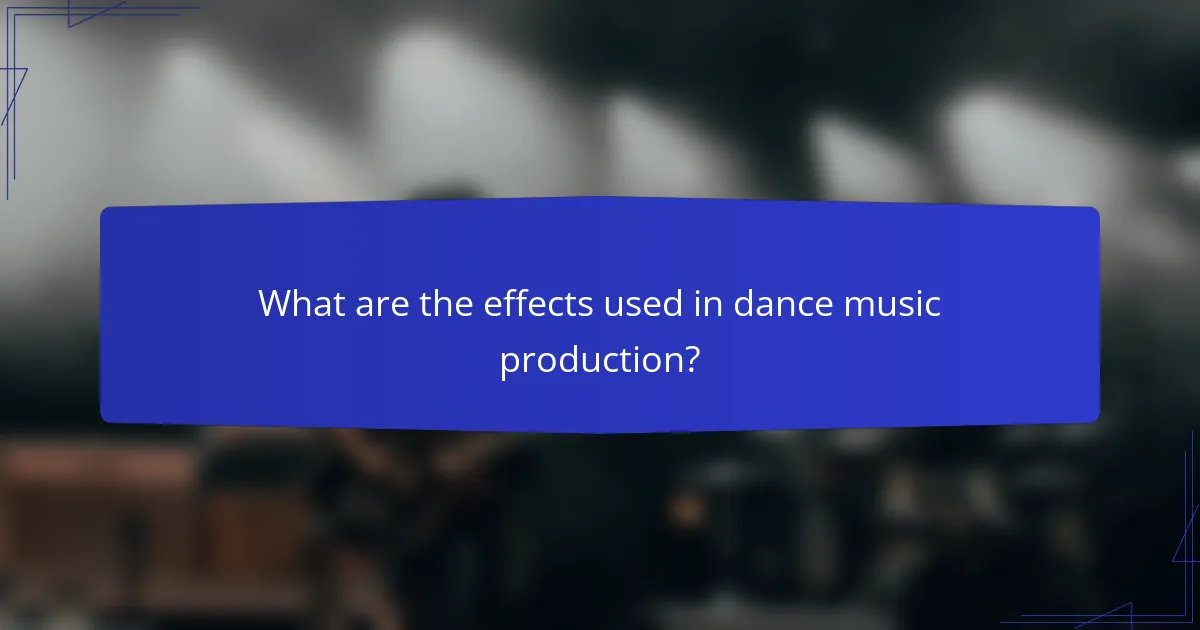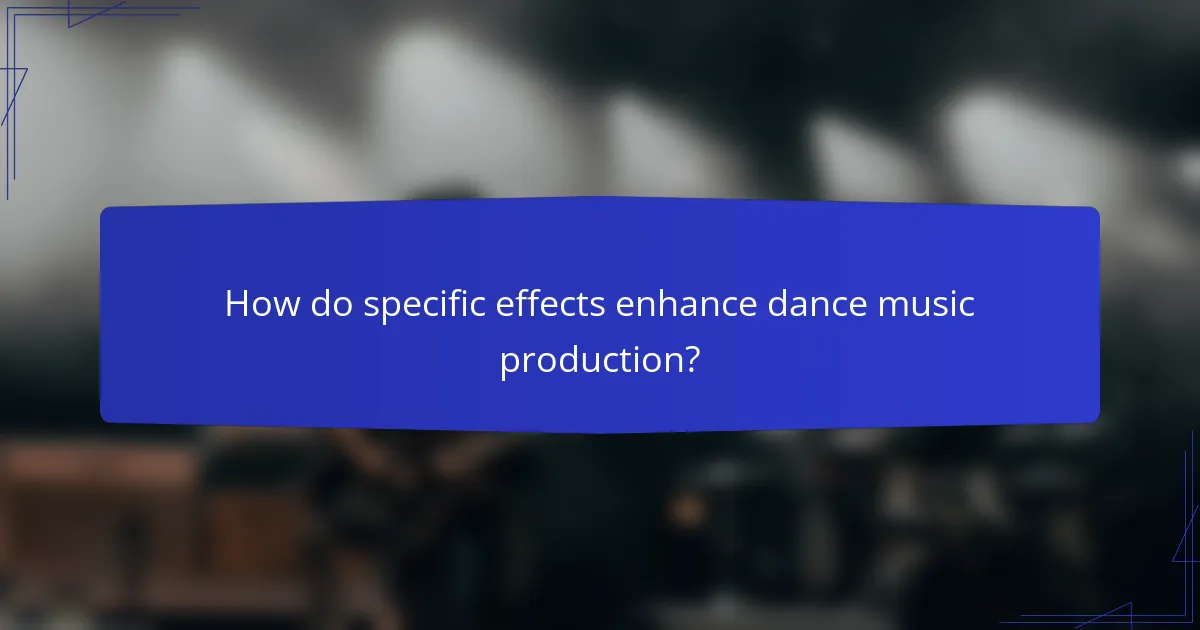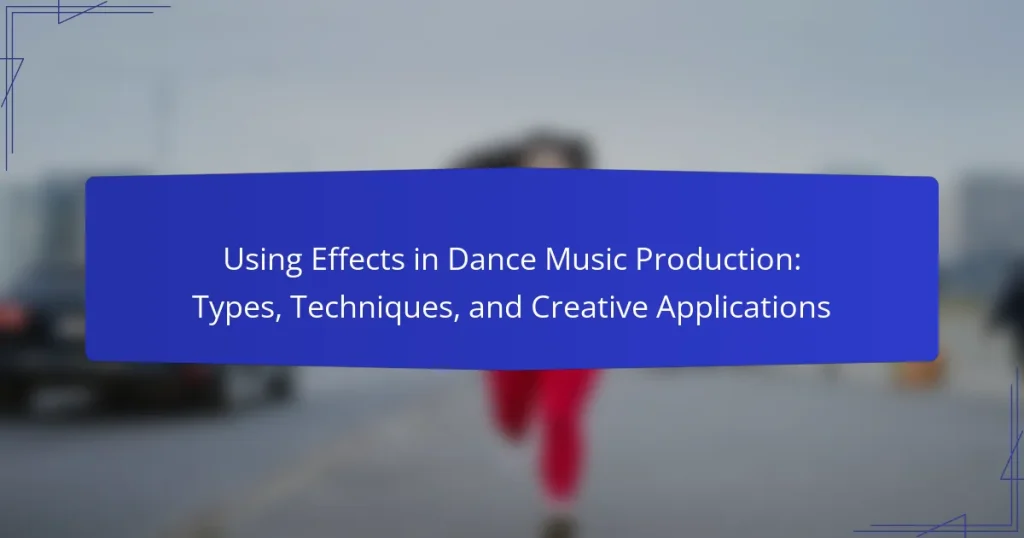The article focuses on the use of effects in dance music production, detailing essential types such as reverb, delay, compression, and equalization. These effects are crucial for enhancing sound quality, creating depth, and shaping the overall tonal quality of tracks across genres like house, techno, and trance. Key techniques include understanding the purpose of each effect, automating them for variation, and layering them to achieve unique sounds while avoiding over-processing. Best practices for applying these effects are also discussed, emphasizing the importance of context and referencing mixes in various playback environments to ensure optimal sound translation.

What are the effects used in dance music production?
The effects used in dance music production include reverb, delay, compression, and equalization. Reverb adds depth and space to sounds, creating an immersive atmosphere. Delay creates echoes that enhance rhythm and texture. Compression controls the dynamic range of audio, ensuring a balanced mix. Equalization adjusts frequency levels, shaping the tonal quality of sounds. These effects are essential for achieving a polished and professional sound in dance music. They are widely utilized in various genres, including house, techno, and trance.
How do different effects influence the sound of dance music?
Different effects significantly influence the sound of dance music by altering audio characteristics. Reverb adds depth and space, creating an immersive listening experience. Delay creates echoes that can enhance rhythmic patterns. Distortion adds warmth and grit, making sounds more aggressive and lively. Equalization shapes the frequency spectrum, allowing certain elements to stand out. Compression controls dynamic range, ensuring consistent levels throughout a track. Modulation effects, like chorus and flanger, introduce movement and richness to sounds. Each effect contributes uniquely, shaping the overall texture and energy of dance music.
What are the primary types of effects in dance music production?
The primary types of effects in dance music production include reverb, delay, distortion, compression, and equalization. Reverb simulates the natural echo of sound in a space, adding depth. Delay creates repeats of sound, enhancing rhythmic elements. Distortion alters the sound wave, adding warmth or grit. Compression controls dynamic range, making sounds more consistent. Equalization adjusts frequency balance, shaping the overall tone. These effects are essential tools for enhancing creativity and sound design in dance music.
How do effects shape the emotional impact of a track?
Effects shape the emotional impact of a track by altering sound characteristics and enhancing listener perception. They can create atmosphere, tension, or release, influencing how a listener feels. Reverb adds depth and space, evoking feelings of longing or nostalgia. Delay can create a sense of movement or urgency, impacting emotional engagement. Distortion can introduce intensity or aggression, altering the emotional tone. Modulation effects like chorus or flanger can evoke warmth or dreaminess, enhancing emotional resonance. Studies show that specific effects can elicit measurable emotional responses in listeners, confirming their significant role in music production.
What techniques are commonly used in applying effects?
Common techniques used in applying effects include equalization, compression, reverb, and delay. Equalization adjusts the frequency balance of a sound. Compression controls the dynamic range, making quiet sounds louder and loud sounds quieter. Reverb simulates the natural reflections of sound in a space. Delay creates echoes by repeating a sound at specified intervals. These techniques enhance the overall sound quality and character of the music. Each technique has specific applications in dance music production, contributing to its unique sonic landscape.
How can modulation enhance the use of effects in dance music?
Modulation can enhance the use of effects in dance music by adding dynamic movement and variation to sounds. It allows producers to create evolving textures and maintain listener interest. For example, using modulation on reverb can create a sense of space that changes over time. Additionally, modulation can be applied to parameters of effects like delay, distortion, and filters. This results in sounds that feel alive and responsive. According to a study by the Journal of the Audio Engineering Society, modulation techniques significantly impact listener engagement in electronic music. Thus, effective modulation can transform static sounds into immersive auditory experiences.
What role does automation play in effect application?
Automation plays a crucial role in effect application by allowing precise control over parameters over time. It enables producers to modify effects dynamically throughout a track. This can include altering reverb levels, delay times, or filter cutoffs. Automation creates movement and interest in the mix. It enhances the emotional impact of music by emphasizing specific elements. For example, increasing a filter’s resonance during a build-up can heighten tension. Additionally, automation helps in achieving a polished and professional sound. It ensures that effects are not static, making the overall production more engaging.
What creative applications exist for effects in dance music?
Creative applications for effects in dance music include sound design, atmosphere creation, and dynamic transitions. Effects such as reverb and delay enhance spatial qualities. Distortion and modulation can add texture and depth to sounds. Filtering techniques can create build-ups and drops, essential in dance tracks. Automation allows for evolving soundscapes throughout a track. Effects can also be used to manipulate vocals, adding unique character. These applications contribute to the overall emotional impact of the music. The use of effects shapes the listener’s experience and engagement with the track.
How can effects be used to create unique soundscapes?
Effects can be used to create unique soundscapes by manipulating audio characteristics. Effects such as reverb, delay, and modulation can alter the spatial perception of sound. Reverb adds depth by simulating the acoustics of different environments. Delay creates echoes, enhancing the rhythmic feel and complexity of sound. Modulation effects, like chorus or flanger, introduce movement and richness to audio. Layering multiple effects can produce intricate textures. For instance, combining reverb and delay can create a lush, expansive atmosphere. These techniques allow producers to craft immersive experiences that engage listeners.
What are some innovative ways to layer effects in a mix?
Layering effects in a mix can enhance depth and texture. One innovative method is using parallel processing. This technique allows the original signal and processed signal to blend, maintaining clarity. Another approach is to utilize automation. Automating effect parameters can create dynamic changes throughout the track.
Creative use of modulation effects, like chorus or flanger, can add movement. Applying these effects to different frequency bands can create a more complex sound. Additionally, experimenting with reverb and delay on different elements can create spatial depth.
Using unique effects chains can also yield interesting results. For example, combining distortion with modulation can create unique textures. Employing sidechain compression with reverb can maintain clarity while adding ambiance. These methods demonstrate how innovative layering can enrich a mix.

How do specific effects enhance dance music production?
Specific effects enhance dance music production by adding depth, texture, and emotional impact to tracks. Reverb creates space and atmosphere, making sounds feel more immersive. Delay creates rhythmic patterns that can enhance groove and keep listeners engaged. Distortion adds warmth and character, making sounds more dynamic and exciting. Compression balances levels, ensuring that elements sit well in the mix. EQ allows producers to carve out frequencies, improving clarity and separation. These effects contribute to the overall sonic landscape, making tracks more appealing and memorable. Research shows that well-implemented effects can significantly increase listener enjoyment and retention in dance music.
What is the role of reverb in dance music?
Reverb in dance music creates a sense of space and depth. It simulates the natural reflections of sound in an environment. This effect enhances the overall atmosphere of a track. Reverb can make sounds feel larger and more immersive. It is often used on vocals, drums, and synths. The use of reverb can help blend elements together. It adds warmth and richness to the mix. Additionally, reverb can influence the emotional impact of a song.
How does reverb affect the spatial perception of sound?
Reverb enhances the spatial perception of sound by simulating the natural reflections that occur in an environment. It creates a sense of depth and distance in audio. This effect allows listeners to perceive the size and characteristics of the space where the sound occurs. For example, a large hall will produce longer and more complex reverb tails than a small room. Research indicates that reverb can influence the localization of sound sources. The brain uses reverberation cues to determine the position of sounds in space. Studies have shown that increased reverb can make sounds appear farther away. This phenomenon is crucial in music production, as it helps create immersive listening experiences.
What are the best practices for using reverb in a mix?
Use reverb to create space and depth in a mix. Apply it selectively to individual elements. Avoid overusing reverb to prevent a muddy sound. Choose a reverb type that complements the genre. Adjust decay time based on the tempo of the track. Use pre-delay to maintain clarity in vocals and instruments. Experiment with different wet/dry ratios for desired effect. Automate reverb levels for dynamic changes throughout the mix.
How does delay contribute to the rhythm of a track?
Delay enhances the rhythm of a track by creating a sense of space and movement. It adds echoes that can fill in gaps between beats. This effect can make a track feel more dynamic and engaging. By adjusting the timing of the delay, producers can sync it with the tempo of the track. This synchronization reinforces the rhythmic elements present in the music. Additionally, delay can create polyrhythms by layering different delay times. This layering introduces complexity and interest to the rhythm. In many dance tracks, delay is used to build tension before a drop, enhancing the listener’s experience.
What types of delay are most effective in dance music?
The most effective types of delay in dance music are digital delay, analog delay, and ping-pong delay. Digital delay offers precise timing and can create complex rhythmic patterns. It is often used for creating tight echoes that enhance the groove. Analog delay provides a warmer sound with a natural degradation over time. This type is preferred for adding character and depth to sounds. Ping-pong delay alternates the echoes between the left and right channels. This effect creates a spacious and immersive experience in the mix. Each delay type serves unique purposes, enhancing the overall production quality in dance music.
How can delay be creatively manipulated for unique effects?
Delay can be creatively manipulated for unique effects by adjusting parameters such as feedback, time, and modulation. Varying the feedback level creates echoes that can build intensity or create a sense of space. Altering the delay time can produce rhythmic patterns that enhance the groove of a track. Modulating the delay time adds movement and unpredictability, resulting in dynamic soundscapes. Using multiple delay lines with different settings can create complex textures. Panning delays across the stereo field can enhance spatial effects. These techniques are commonly employed in dance music production to add depth and interest.

What are the best practices for using effects in dance music production?
The best practices for using effects in dance music production include understanding the purpose of each effect. Effects such as reverb, delay, and compression enhance sound quality and create depth. Use reverb to add space and atmosphere to tracks. Delay can create rhythmic interest and fullness. Compression helps to balance dynamics and maintain consistent levels.
Additionally, automate effects to add movement and variation throughout the track. Layer different effects to create unique sounds, but avoid over-processing, which can muddy the mix. Always consider the context of the track when applying effects. Finally, regularly reference mixes in different environments to ensure the effects translate well across various playback systems.
How can producers avoid common pitfalls when applying effects?
Producers can avoid common pitfalls when applying effects by understanding the purpose of each effect. They should use effects to enhance the sound, not to mask poor production quality. It’s crucial to apply effects subtly to maintain clarity in the mix. Overusing effects can lead to a muddy sound, which is a common mistake. Producers should also consider the context of the track when choosing effects. Testing effects on different sound elements can help in making better decisions. Regularly referencing the mix against professional tracks can provide valuable insights. Finally, producers should seek feedback from peers to identify any missteps in their use of effects.
What are the key considerations for maintaining clarity in a mix?
Key considerations for maintaining clarity in a mix include proper frequency balance, dynamic range control, and spatial placement of sounds. Frequency balance ensures that no single element dominates the mix, allowing each sound to be heard clearly. Dynamic range control prevents unwanted peaks and maintains consistent levels, which aids in clarity. Spatial placement involves using panning and reverb to create a sense of space, helping to distinguish different elements in the mix. Additionally, using EQ effectively can carve out space for each instrument, enhancing overall clarity. These practices are essential for achieving a professional-sounding mix that communicates effectively.
How can effects be balanced to enhance rather than overwhelm?
Effects can be balanced to enhance rather than overwhelm by carefully adjusting their levels and parameters. This involves using equalization to carve out space for each effect. It is essential to maintain clarity in the mix. Reverb and delay should be applied subtly to avoid muddying the sound. Compression can help control dynamic range and ensure effects sit well in the mix. Automation allows for dynamic changes in effect levels throughout a track. Using effects in moderation prevents listener fatigue. A/B testing different levels can identify the right balance. Ultimately, a well-balanced mix enhances the overall listening experience without overwhelming the audience.
What tips can help maximize the creative potential of effects?
To maximize the creative potential of effects in dance music production, experiment with layering multiple effects. This technique allows for richer sound textures. Use modulation to create movement within effects, enhancing dynamic interest. Automation can further refine these effects, adding variation over time. Try unconventional combinations of effects to discover unique sounds. Adjust parameters in real-time to inspire spontaneity during the production process. Utilize effects in different contexts, such as mixing and mastering, to achieve diverse outcomes. These strategies are supported by industry practices that emphasize creativity through experimentation and innovation.
How can experimentation lead to innovative sound design?
Experimentation can lead to innovative sound design by encouraging the exploration of new techniques and tools. By manipulating sound sources in unconventional ways, creators can discover unique audio textures. This approach often results in sounds that differ from traditional methods. For example, using found sounds or field recordings can add unexpected elements to music. Additionally, layering effects such as reverb and distortion can create rich, complex soundscapes. Historical examples include artists like Brian Eno, who pioneered ambient music through experimental techniques. The use of modular synthesizers also exemplifies how experimentation can yield novel sound outcomes. Overall, experimentation broadens the creative palette for sound designers, leading to fresh and innovative results.
What resources are available for learning more about effects in dance music?
Books on music production offer detailed insights into effects in dance music. “The Mixing Engineer’s Handbook” by Bobby Owsinski is a comprehensive resource. Online courses from platforms like Coursera and Skillshare cover audio effects in depth. YouTube channels such as ADSR Music Production Tutorials provide practical demonstrations. Websites like Sound on Sound and MusicTech feature articles on effects techniques. Forums like Gearslutz allow for community discussions on effects. These resources collectively enhance understanding of effects in dance music.
The main entity of this article is the application of effects in dance music production. It covers various types of effects such as reverb, delay, distortion, compression, and equalization, detailing how each contributes to sound quality and emotional impact. Key techniques for applying these effects include automation and modulation, which enhance creativity and listener engagement. The article also addresses best practices for maintaining clarity and balance in mixes, along with innovative ways to layer effects for unique soundscapes. Additionally, it provides resources for further learning about effects in dance music.


